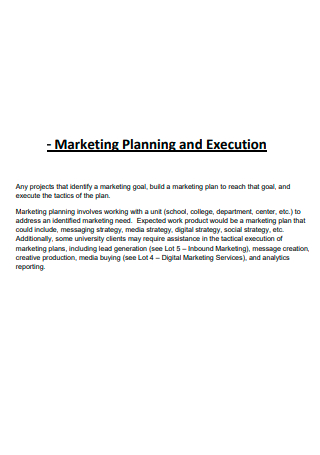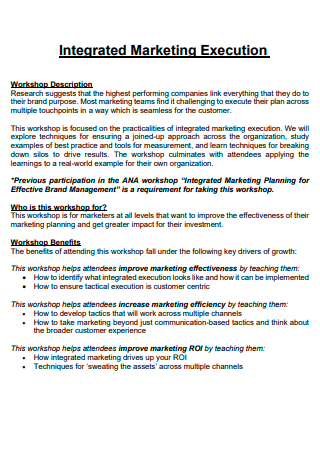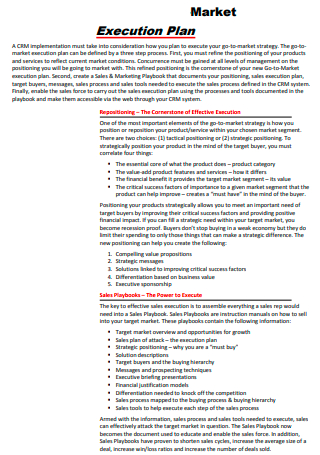3+ Sample Marketing Execution Plan
FREE Marketing Execution Plan s to Download
3+ Sample Marketing Execution Plan
What Is a Marketing Execution Plan?
Why Is Marketing Execution Plan Important?
What Are the Types of Marketing Strategies?
What Are the Components of A Marketing Execution Plan?
Steps of Marketing Execution Plan:
FAQs
What makes a strong marketing plan?
What are examples of activities to improve marketing efforts?
Is marketing to businesses different from consumer marketing?
How do I know what my sales will be?
How do I track what marketing methods are working?
What Is a Marketing Execution Plan?
Marketing execution is the process that turns your marketing strategy into action. It brings your marketing goals and tactics to life. With marketing execution, you’ll turn your strategy into real-life activities so you can deliver the right content to the right people at the right time. You already know that your marketing strategy is a guide that helps you choose, prioritize, plan, and execute projects that ultimately improve your company’s bottom line. Marketing execution will make sure everyone on your team:
- Knows exactly what to work on day after day
- Takes ownership of their tasks and understands how their work impacts everyone else’s
- Gets to do their best work because they don’t have more tasks on their plate than they can handle
In order to develop a Marketing Strategy Execution Plan, you must start with the end in mind. There are specific objectives developed in order to meet the client’s goals. This entails an in-depth on-boarding process in order to set objectives and goals.
Why Is Marketing Execution Plan Important?
A Marketing Execution Plan is one of the most important business tools for any company to utilize. Execution makes all the necessary elements of marketing work to bring strategy to life. For instance, tradeshows, advertising, public relations, social media contribution and a blog can coordinate to generate leads. It helps you uncover the goals of the people behind the company or organization you call client. Ultimately, those are the individuals affected by this campaign. You could make their job a lot easier, grow their business, and help them align their goals with their co-partners.
The marketing execution plan is the missing link between the strategic direction of the business and the delivery of results. It is the glue that connects everything together and ensures that the right activity is taking place, at the right time, to the right audience through the right channels. A marketing plan ensures all activities that are taking place, are in line with the direction the business is strategically going, rather than merely following the entrepreneurial leader’s latest idea.
What Are the Types of Marketing Strategies?
The requirements of the contemporary marketing environment necessitate the development of new practices and theories that will help organizations in successfully marketing themselves in modern times.
Social Marketing
Social marketing is the application of commercial marketing principles to achieve a social good. The main goal of social marketing is not to make financial gains, but to bring about behavioral change for societal benefit. It includes promoting the use of seatbelts while driving, promoting regular health checkups, persuading people to get their children vaccinated, asking people to give up tobacco use, etc. The social marketing group should interact with the people, get involved with them and encourage them to bring about changes in their beliefs and lifestyles. An effective communication policy is very vital for making the people adopt changes. The essence of social marketing is to bring about positive changes in people’s behavior.
Service Marketing
Services are very different from products and as such they need different strategies to be successfully marketed. In addition, services are intangible economic activities that fulfill certain needs of a customer. Some services are purely intangible in nature while some are associated with tangible goods. Production and delivery of services is simultaneous, i.e., services cannot be stored and are consumed at the point of sale. They cannot be seen or touched, but only experienced. Some examples of services are banking, insurance, hair dressing, catering, medical services, etc. No two instances of service exposure are same. Even if the same service provider is providing the service to different clients, some differences, however minute are prone to be there. It is more difficult to standardize services than it is to standardize products. The quality of service also depends upon the place and time it was delivered on.
Green Marketing
Green marketing is also known as sustainable marketing. Green companies may produce goods that are environmentally friendly or adopt a production method that is least damaging to natural resources. Green marketing is the marketing of products in an environmentally friendly way. It combines the satisfaction of consumer’s wants and needs with the conservation and protection of the natural environment. The ecological benefits of green marketing may be in forms of reduced waste, decreased emissions of toxins, better energy efficiency, etc.
Holistic Marketing
Holistic marketing considers the whole business system while developing a marketing strategy. Each component of the marketing strategy is designed as a part of an overall unified strategy. The emphasis is not only on the products and services provided but also on the people who are involved in creating and marketing them. Holistic marketing enables the company to view its marketing efforts as a “whole” and develop an overall complete marketing plan.
Direct Marketing
Mass media advertising may reach a larger audience, but it is possible that a major portion of that audience is not even interested in the product. Direct marketing is the method of selling goods and services directly to the customers rather than through retailers. Firms involved in direct marketing communicate directly with the target customers with specific promotional techniques. It helps the business to build better customer relations because the business connects to the prospective customers directly. Direct marketing scores an advantage here—only those people are contacted who would be genuinely interested in the product.
What Are the Components of A Marketing Execution Plan?
Steps of Marketing Execution Plan:
Step 1: Prepare a mission statement. Be sure to be trustworthy when creating this statement as it should be a reflection of your business’ practices. The mission statement briefly outline’s your business’ values and services.
Step 2: Determine your audience. Use these personas as part of your marketing plan to know how to best reach them. Knowing your audience is knowing how to best market them. Do some research and create personas for your target audience or niche market.
Step 3: Describe your services. You must be able to describe them to effectively market your services. Take inventory of services you currently offer and those you do not but would like to.
Step 4: Spell out marketing and promotional strategies. There are many options to choose from when it comes to marketing strategies with social media and other channels. This is a trial-and-error process that requires testing and interaction with clients or prospective clients.
Step 5: Know your competitors. A business faces a market that is more competitive than ever with widespread Internet access through smartphones. In order to compete, you must learn about your competitors and yourself. Determine your strengths and how you can compare to similar businesses based on value, price, products, services, or some combination of these.
Step 6: Monitor your results. Make tracking data about your clients easier than ever before through free online analytics programs for both social media and websites. This allows you to better determine how well your marketing strategies are working and who your potential clients are.
FAQs
What makes a strong marketing plan?
You can measure it by the decisions that follow, the business it generates and how well it is implemented. A brilliant marketing plan that is not executed is worth much less than a mediocre marketing plan that is carried out.
Market focus
Good marketing plans define target markets narrowly. Businesses’ target market might be families, couples, baby boomers, teenagers, children, date nights, busy and rushed working people, or some combination. Choose. Divide and conquer.
Product focus
Product focus matches market focus. If you want baby boomers’ date nights, then serve good food. If you want families with kids, then serve food quickly, make the menu items relatively cheap and, of course, the food has to be safe.
Concrete, measurable specifics
A good marketing plan is full of dates and details. Strategy probably drives a good plan, but tactics, programs and details make the difference. As much as possible, the plan has to tie results back to activities and come up with hard numbers to measure those results.
It needs specifics that are related to marketing message, insertions, posts, tweets, dinners served, return visits, members of the e-mail list, reviews, stars and so forth.
The key is to take a plan and think ahead about how you will know whether it was implemented.
Responsibility and accountability
Assign every part of a marketing plan to a specific person. Measure the results of every task and be sure a person is responsible for it. Peer pressure is important: The people executing the plan have to be accountable for measurable results. Failure has to hurt, and achievement has to be rewarded. A good marketing plan needs commitment, not just involvement.
Reviews and revisions
Every successful marketing plan is actually a planning process, not just a plan. Things change too fast for static plans. A good marketing plan is part of a process that involves setting goals, measuring results and tracking performance. It entails regular review and revision.
There is no marketing plan if the group running the marketing plan is not meeting once a month to compare the plan with actual results and make course corrections.
What are examples of activities to improve marketing efforts?
Data collections
Each one of your customer segments expect a different experience with your brand. If you are treating loyal customers, one-time customers and prospects all the same way, you are probably not serving any of these groups with the exclusivity they deserve.
Upon collect and analyzing data from multiple marketing channels and aggregating it in one place you will be able to understand each of your customers’ segments deeply and then treat them accordingly.
Content creation
After classifying each of your customers’ segments by demographics and behaviors, you will be able to create content that is relevant for each one of them.
As an example, many companies have “We miss you” email campaigns focused on reactivate customers that become inactive after opening a new account.
Target users that abandoned the shopping cart or online form
If someone has already been into your website, added products into their shopping cart or started filling out a form on your website but then left for some reason, there are good chances this person is interested in your product or service. Use an automatic re-marketing campaign to reacquire these customers before they go to a competitor.
Welcome or activation programs
Make a strong first impression. Automating welcome or activation campaigns will allow you to introduce your company better, explain how your customer can get the most out of your product or service and collect additional customer information.
Collect reviews
Collecting and analyzing your customers` feedback is essential to provide a great service. By the way, the only way to know if your customers are happy with your company is by asking them.
Birthdays messages
Buyers are people. Even companies are made of people. Interact with your customer in a personal way and let them know you care about them. A simple birthday greeting can help you to differentiate your company from your competitors.
Sales emails
Automated sales emails are a great opportunity to educate your customers about your products and policies, offer upsells and finish transactions in the event the customer missed any steps.
Post sales email
Remember to ask if your customers are happy with your product and if they can tell their friends about you. Don`t miss the opportunity to retain your customers and find new ones through word of mouth and social media referral.
Events
Use automated event tools to send invitations, confirm if your guests are coming and remind them about dates and times of upcoming promotions or events.
Customer lifecycle
People change in many ways. They get married, change interests, make new friends and have new priorities. Use automated tools to understand how your customers are changing, and adjust your offer to satisfy these changes. For example, if you have a B2B business, you should not use your marketing money on people that went out of business.
Is marketing to businesses different from consumer marketing?
Business-to-business marketing tends to be more targeted, as prospects can be more easily identified. Business-to-business marketing typically revolves around building relationships – through networking, personalized marketing communications and direct selling.
How do I know what my sales will be?
Sales forecasting is not an exact science, but it is much easier for established businesses that can base their estimates on last year’s figures. Start-ups should beware of basing their plans on sales forecasts that are too ambitious. Companies House can provide you with copies of the accounts filed by your competitors – but only, of course, limited companies. It’s worth measuring your progress against the market leader but expecting to grab any more than 5% of the market would be ambitious in the first year.
How do I track what marketing methods are working?
For most businesses, 80% of the most profitable sales come from 20% of the customers. Track what is happening with these key customers to safeguard the most important chunk of your business. It is important to monitor the number of new contacts made each week and to check how many of these result in a sale. Without new contacts in the pipeline, sales will dry up. Be alert for mistakes – the stage at which the sales process breaks down will give a valuable insight into possible areas for improvement. Similarly, there will be a point in your sales pitch where you typically get the buyer’s agreement. Learn from both the positive and negative experiences. You should measure the effectiveness of all of your marketing efforts. Most online marketing – including social media, website content and email marketing – offers tools for analyzing customer engagement. These tools can help you discover what is working and what is having a limited impact.
A sound plan will help you get started. The marketing planning helps in coordinating all the managerial activities of the firm. It not only helps in coordinating the work of its own department but also helps in coordinating the managerial activities of all the other departments to achieve the overall objectives and goals of the firm. The marketing plan, meanwhile, is the blueprint of how the marketing strategy is going to be implemented. It is much more tactical in its nature. Remember, if you are not bringing in leads, you need better marketing.




